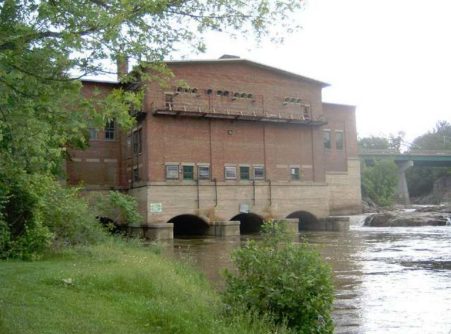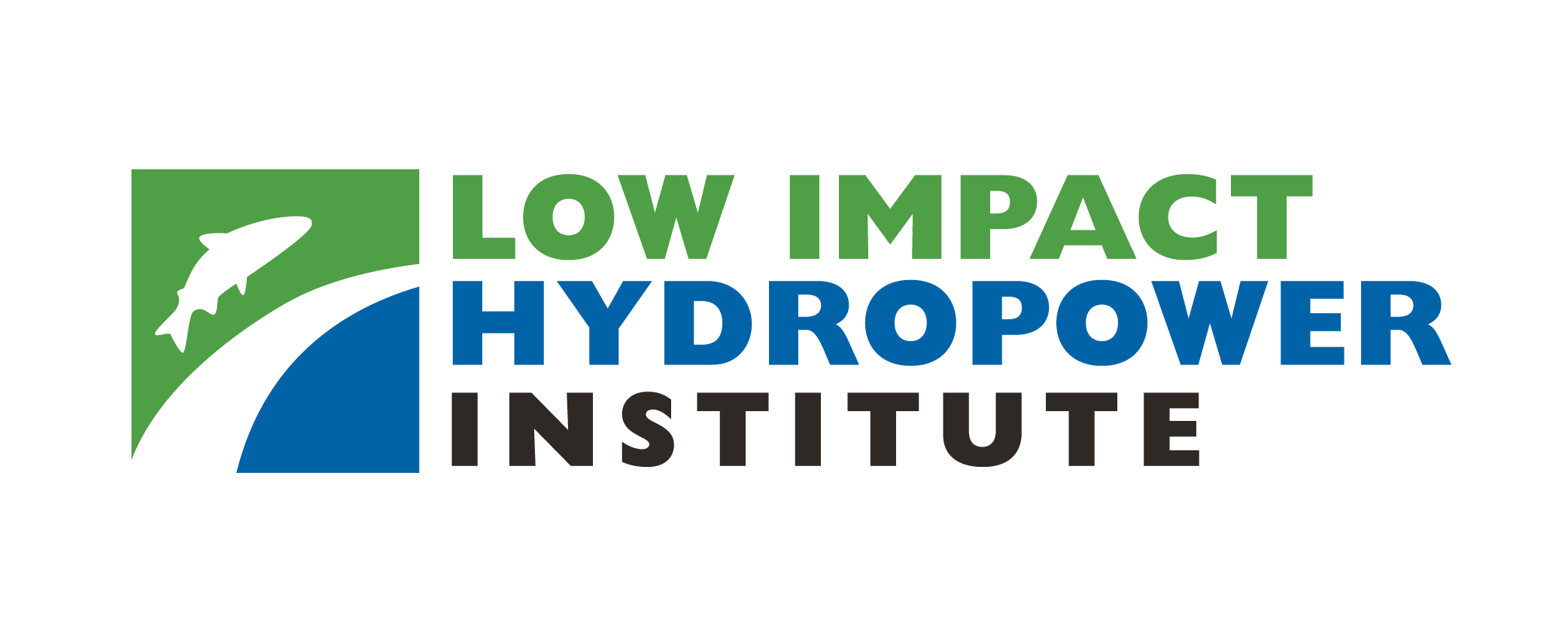LIHI 證書 #146 – 佛蒙特州埃塞克斯郡 19 項目


| 項目名稱 | 埃塞克斯 19 |
| 理海證書編號 | 146 |
| LIHI 證書期限 |
2018 年 10 月 31 日 – 2023 年 10 月 30 日延長至 2026 年 10 月 30 日 |
| 擁有者 | 綠山電力公司 |
| 狀態 | 佛蒙特 |
| 地點 | 位於佛蒙特州奇滕登縣埃塞克斯交界處和威利斯頓鎮的威努斯基河主幹道上,河流長 17.6 英里。 |
| 裝置容量 | 8.05兆瓦 |
| 平均年發電量 | 42,925 兆瓦時 |
| 設施類型 | 修改的 達到峰值 |
| 聯邦能源監管委員會 不。 | P-2513 於 1995 年簽發,效期至 2025 年 2 月 28 日 |
艾塞克斯 19 計畫位於佛蒙特州奇滕登縣埃塞克斯交界處和威利斯頓鎮的威努斯基河主幹道上。威努斯基河向西北流入尚普蘭湖。這 壩 於 1913 年至 1917 年間在哈伯瀑佈建造,但自 18 世紀末以來,該位置就有一座水壩。原來的水壩於 1798 年被沖毀,隨後在現址上游又建造了另一座水壩。 1830 年以後,在目前水壩位置的下游建造了一座木壩。該項目位於其他九個水力發電項目的下游,包括 Winooski 8號專案(LIHI #77)。繼續往下游走,還有另外兩個水力發電項目,其中一個是 Winooski One(Chace Mill)計畫(LIHI #16)。 Essex 19 專案由 Green Mountain Power (GMP) 擁有,該公司是第一家獲得 B 類公司。
該項目包括混凝土 重力壩, 溢洪道, 六 壓力管道, 發電站、四台弗朗西斯式水輪機、一台最小流量機組、旁路段,以及 魚道 設施。
大壩長 495 英尺,其中一段為非控制溢洪道,長 345 英尺,高 45 英尺,頂部裝有 5 英尺高的充氣 閃光板,以及一個 84 英尺長、45 英尺高的翼尖部分,頂部配有 6.5 英尺高的充氣式閘板。兩根直徑 3 英尺的鋼/導流 壓力水管和四根直徑 9 英尺的鋼/引水壓力水管從大壩延伸至發電站。發電站內有四台臥式弗朗西斯水輪機,以及一台位於舊的未使用的勵磁機組艙內的最小流量機組,該機組為雙臥式弗朗西斯式水輪機。總裝置容量為8.05兆瓦。
該項目主要作為經過改造的調峰設施運行,季節性 徑流 運作並攔截 352 英畝的水庫。流量隨季節變化:
- 從 5 月 16 日到 6 月 15 日,該計畫提供最低 1,000 立方英尺/秒的流量,或流入量(如果流量較少),以保護大西洋鱘魚的產卵和孵化棲息地。
- 從 6 月 16 日到 3 月 31 日,該計畫提供最低 450 立方英尺/秒的流量,或流入量(如果流量較小),以保護鮭魚棲息地。
- 從 4 月 1 日到 5 月 15 日,該項目以徑流模式運行,最小流量為 50 立方英尺/秒,如果更小則為流入量,通過魚道設施進入繞行河段(自安裝最小流量單元以來,該項目將所有小於 100 立方英尺/秒的流量通過下游魚道設施釋放到繞行河段)。為了保護梭魚的產卵和孵化棲息地,流出量瞬時近似於流入量。
該專案已獲准在 5 月 16 日至 3 月 31 日期間進行有限的調峰運行,但 GMP 並不負責該專案的調峰運行。當河流流量大於 275 立方英尺/秒時,水流將透過旁路(經由下游魚道設施)和渦輪機釋放。當河流流量大於 100 立方英尺/秒時,流量會透過旁路和最小流量單位釋放,當流量低於 100 立方英尺/秒時,流量會透過旁路釋放。該流動制度是與佛蒙特州自然資源局 (VANR) 協商後製定的,以確保水生棲息地的保護。
計畫範圍內的水域,包括計畫上游和下游,均因存在大腸桿菌而被歸類為受損水域。然而,VANR 已確定減損並非由於專案營運造成。下游損害是由伯靈頓市和埃塞克斯市合流污水溢流造成的,而上游損害同樣是由蒙彼利埃污水處理廠溢流造成的。
威努斯基河和尚普蘭湖盆地曾經是許多 溯河洄游魚類 大西洋鱘魚和大西洋鮭等物種。然而,棲息地破壞和過度捕撈有效地 消滅的 這些物種來自該地區大約150年前。此後,人們一直致力於開闢從尚普蘭湖到河流產卵的陸封鮭魚通道。計畫業主與 Winooski One 魚類升降機計畫進行協調,以幫助鮭魚族群遷徙。這 陷阱和卡車 營運成本由各設施分攤,鮭魚被釋放到計畫上游。 2018 年 7 月實施了臨時下游通道措施,並建造了臨時堰壩。在美國魚類和野生動物管理局 (USFWS) 和 VANR 的諮詢下,於 2019 年建造了更多永久性建築。業主將這些機構的建議納入永久性下游魚道堰的建設中,並根據美國魚類及野生動物管理局的要求調整了下游通魚季節。間距為一英吋的垃圾架可以減輕 夾帶.
該項目土地面積約為4.5英畝。雖然計畫區域內沒有具有重大生態價值的土地,但景觀管理計畫負責管理計畫的植被管理。該計劃確保項目工程與景觀融為一體,並維護發電站周圍和繞過河段的植被。
計畫附近可能存在的受威脅或瀕危物種包括北方長耳蝠、印第安納蝙蝠、鵝卵石虎甲蟲、布氏響尾蛇根和三色蝙蝠。專案流動作業不會幹擾上述任何物種,且專案邊界內缺乏適合任何所列物種的棲息地。
工程基礎設施,包括水壩、進水口結構、壓力水管和發電站,均有資格列入 國家歷史遺跡名錄。這些建築代表了第一次世界大戰前佛蒙特州水電工業的形成時期。此專案文化資源管理計畫下所進行的活動年度報告已提交給佛蒙特州歷史保護部門和聯邦能源管理委員會。
此計畫的娛樂資源包括獨木舟搬運、船坡、日間使用區和解說標誌。民眾可免費進入。
合規狀態
此證書包含以下條件:
條件一: 設施所有者應繼續與 VDEC 合作,確定對營運和流程進行持續監控和報告的任何額外需求,與資源機構協商更新專案的營運合規計劃,並在機構同意後向 FERC 提交該計劃。在最終計劃提交給 FERC 並獲得批准之前,業主應在向 LIHI 提交的年度合規聲明中報告這些工作的進展。
2019年滿足條件。條件2: 設施業主應在 2019 年施工季節完成永久性堰改善的安裝,包括任何必要的 瀑布水潭 或與 VDEC 和 USFWS 協商進行岩石改造。業主應向 FERC 提交修訂後的下游通行標準作業程序 (SOP) 和機構要求的春季通行時間調整,並向 LIHI 提供副本。通道運作開始後,業主應與資源機構協商,依照許可證第 410 條或相關更新要求實施下游通道監測和有效性測試。業主應在向 LIHI 提交的年度合規聲明中報告下游通道的狀況。
2025: 未發現任何重大變更或合規問題。根據年度審查,該項目仍然合規。對於條件1,該計畫報告了正在進行的重新許可申請,包括正在進行的下游魚類通道和文化資源研究和諮詢。
2024: 未發現任何重大變更或合規問題。根據年度審查結果,該項目仍然合規。對於條件 1,該計畫報告了正在進行的重新許可情況,包括與下游魚類通道和文化資源相關的研究和諮詢。
2023: 未發現任何重大變更或合規問題。根據年度審查結果,該項目仍然合規。對於條件 1,該專案報告已完成大部分重新許可研究,並於 2023 年 2 月 28 日提交了最終許可申請。
2022: 未發現任何重大變更或合規問題。根據年度審查結果,該項目仍然合規。對於條件 1,本計畫報告已完成水質監測。預計 2022 年將進行河道內繞流和景觀流研究。重新許可文件表明,該項目計劃使用新許可證轉為徑流式運營。
2021: 沒有報告任何變更或合規性問題。根據年度審查結果,該項目仍然合規。對於條件 1,該專案報告向 FERC 提交季度再許可研究報告。
2020: 沒有報告任何變更或合規性問題。根據年度審查結果,該項目仍然合規。該計畫於 2020 年 2 月 27 日提交 PAD,開始向 FERC 申請重新許可。對於條件 1,專案報告的諮詢將在重新許可過程中繼續進行。
2019: 沒有報告合規性問題。該項目根據年度評審結果繼續有效。對於條件 1,該項目報告正在進行的機構諮詢,重點關注下游魚類通道。對於條件 1,該專案報告安裝了堰增強裝置,並且機構批准將下游通行季節延長兩週,從 4 月 15 日到 6 月 30 日,從而滿足了條件。
2018: 目前證書的年度報告尚未生效。
認證歷史
2018年12月18日: 對艾塞克斯 19 水力發電計畫的認證決定是最終決定。申訴期於 2018 年 12 月 16 日結束,未收到任何申訴。此計畫的新認證期限為 2018 年 10 月 31 日至 2023 年 10 月 30 日。
2018年11月16日:低影響水力發電研究所 (LIHI) 初步批准了埃塞克斯 19 水力發電計畫的低影響認證。該決定是初步決定,需等待 30 天的上訴期。只有在 60 天的評論期內對初始申請發表評論的人才有資格提出上訴。此類上訴需要包括有關該項目如何不符合 LIHI 標準的解釋。申訴請求可以透過電子郵件發送至 評論@lowimpactHydro.org 請在主旨欄註明“Essex 19 Hydroelectric Project”,或郵寄至 Low Impact Hydropower Institute, 329 Massachusetts Ave, Suite 2, Lexington, MA 02420。所有請求都將發佈在網站上。申請人將有機會回應,任何回應也將被公佈。 請求必須在 2018 年 12 月 16 日美國東部時間下午 5 點之前收到。 完整的申請和審閱者報告如下。如果沒有收到上訴請求且決定成為最終決定,則 Essex 19 計畫的認證期限為 2018 年 10 月 31 日至 2023 年 10 月 30 日。
2016年1月6日: 2016 年 12 月 30 日,低影響水力發電研究所 (LIHI) 收到了綠山電力公司提交的一份完整的申請,要求對位於佛蒙特州奇滕登縣埃塞克斯交界處和威利斯頓鎮威努斯基河主幹道 17.6 英里處的埃塞克斯 19 水電項目進行低影響認證。
認證文件
2018 年認證
- 埃塞克斯 19 認證審查報告最終版 2018
- 埃塞克斯 19 LIHI 認證申請 2016
- 美國魚類和野生動物管理局 2016 年評論信
- 佛蒙特州環境保護部 2017 年意見函
- 綠山電力公司對佛蒙特州環境保護部 2017 年意見函的回复
